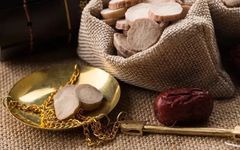
Bai Shao (White Peony) has a bitter and sour taste, and is slightly cold in nature.
It enters the liver (gan) and spleen (pi) meridians. It nourishes the blood and astringes yin,
softens the liver and alleviates pain.
It is indicated for irregular menstruation,
excessive bleeding, vaginal discharge, dizziness, headaches,
spontaneous sweating, night sweats, diarrhea, and abdominal pain.
Bai Shao has a bitter and sour taste, and is slightly cold in nature. It enters the liver and spleen meridians. It nourishes the blood and astringes yin, softens the liver and alleviates pain. It is indicated for irregular menstruation, excessive bleeding, dizziness, headaches, spontaneous sweating, night sweats, diarrhea, and abdominal pain.
The famous physician of the Eastern Han Dynasty, Hua Tuo, established a medicinal garden, dug a medicinal pool, built a pharmacy, and cultivated herbs, widely teaching, planting, and processing techniques for traditional Chinese medicinal materials. He would carefully taste each herb to understand its properties before using it on patients.
Bai Shao

Once, a traveler gifted Hua Tuo a peony plant, which he planted in front of his house. After tasting the leaves, stems, and flowers of this peony, he found it ordinary and seemingly without medicinal properties.
One night, while reading under the lamp, Hua Tuo suddenly heard a woman’s crying. Puzzled, he went outside but saw no one, only the peony plant. He thought to himself: could it be that this plant was the one crying? He looked at the peony flower, shook his head, and muttered, “You have no remarkable qualities, how could you be used as medicine?” He turned back to continue reading.
Just as he sat down, he heard the crying again. When he went out to check, it was still the peony. Hua Tuo found it strange and woke his sleeping wife to describe what had happened. His wife looked at the flowers and herbs outside and said, “Every plant in your hands becomes a good medicine, saving countless lives, yet this peony is neglected, it naturally feels wronged.” Hua Tuo laughed and said, “I have tasted hundreds of herbs, and their properties are clear to me. I use what is necessary without missing anything. I have also tasted the leaves, stems, and flowers of this peony multiple times, and it truly cannot be used as medicine. How can it feel wronged?”
Days later, his wife experienced severe abdominal pain and bleeding, and the medicine was ineffective. She secretly dug up the peony root and boiled it to drink.
In less than half a day, her abdominal pain subsided. She told her husband about it, and Hua Tuo realized he had indeed wronged the peony. Later, Hua Tuo conducted detailed experiments on the peony and discovered that it not only stops bleeding and invigorates blood but also has analgesic, nourishing, and menstrual-regulating effects.
Traditional Chinese Herbs
Bai Shao is also known as: Bo Shao, Chuan Shao.
Properties: Bitter, sour, sweet; slightly cold; enters the liver and spleen meridians.
It is a good medicine for nourishing and protecting the liver.
Bai Shao is a key herb for nourishing blood and regulating blood flow, commonly used in gynecology, with effects of nourishing liver blood, regulating liver qi, calming liver yang, and alleviating acute pain. In the “Medical Origins, Volume 2,” it states that Bai Shao has six uses: calming the spleen meridian, treating abdominal pain, collecting stomach qi, stopping diarrhea, harmonizing blood vessels, and solidifying the pores.
Spring
Effects and Indications
Bai Shao nourishes blood, regulates menstruation, calms the liver, and stops pain.
1. Used for menstrual irregularities, dysmenorrhea, and excessive bleeding due to blood deficiency or yin deficiency with heat.
2. Used for pale complexion, dizziness, and tinnitus caused by liver blood deficiency.
3. Used for headaches, rib pain, abdominal pain, and limb cramps caused by liver qi stagnation or excessive liver yang.
4. Used for spontaneous sweating (sweating without exertion, known as spontaneous sweating) or night sweats (sweating during sleep that stops upon waking, known as night sweats).
Precautions
1. Bai Shao should not be used with Li Lu.
2. It is not suitable for abdominal pain, diarrhea, or early measles with exterior symptoms or unrelieved rashes due to yang deficiency and cold.
Ancient and Modern Recipes
1. For treating whooping cough:
Bai Shao 15 grams, Gan Cao (Licorice) 5 grams, decoct in water daily. Adjust herbs according to symptoms. If coughing frequently, add Bai Bu (Stemona) and Bai He (Lily); if wheezing with phlegm, add Di Long (Earthworm), Ting Li Zi (Descurainia Seed), and Wu Gong (Centipede).
2. For skin whitening and moisturizing:
Bai Shao, Bai Zhu (Atractylodes), and Bai Fu Ling (Poria) each 5 grams, Gan Cao 2.5 grams, decoct in water and take warm. Suitable for rough, dark skin and chloasma caused by qi and blood deficiency with cold.
Traditional Chinese Herbs
-END-


